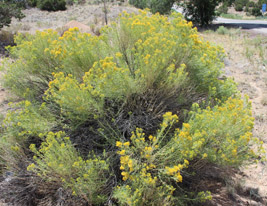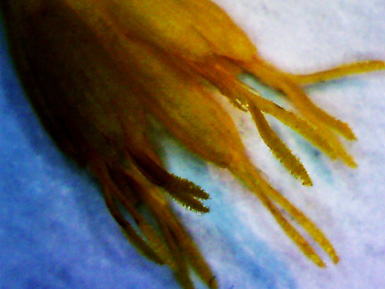 |
 |
| Plant w/Flowers |
Plant w/Seeds |
The Flowers
 |
 |
50X |
Description
"Plants mostly 20-60 cm . Stems grayish to white, leafy, loosely tomentose . Leaves grayish green to white; blades 1-nerved, narrowly linear, 10-50 × 1-1.5 mm, faces loosely tomentose. Involucres 7-10.5 mm. Phyllaries 10-18, apices erect, mostly obtuse, abaxial faces tomentose, sometimes sparingly. Corollas 6.5-9 mm, tubes usually puberulent, rarely arachnose, lobes 1-2 mm, glabrous; style appendages longer than stigmatic portions. Cypselae densely hairy; pappi 5.2-7.2 mm. 2n = 18. Flowering late summer-fall." (SEINet)
"It grows in the arid regions of western Canada, western United States (from the western Great Plains to the Pacific) and northern Mexico.[2]" (Wikipedia)
Ethnobotanical Uses
Other Uses:
"The Zuni people use the blossoms bigelovii variety of the nauseosa subspecies to make a yellow dye.[14] They use the stems to make baskets.[15]
Possible commercial uses:
Rubber rabbitbrush was considered as a source of rubber as early as 1904.[16] Several studies have been conducted on the possible use of rubber rabbitbrush as a source of rubber including ones during World Wars I and II, and 1987.[17] Currently the University of Nevada is conducting research on possible of uses of rubber rabbitbrush for biomaterial and bioenergy uses.[18] One possible commercial use of rubber rabbitbrush would be as a source for hypoallergenic rubber for use in products designed for people with latex allergies.[19]" (Wikipedia)
Internet Resources